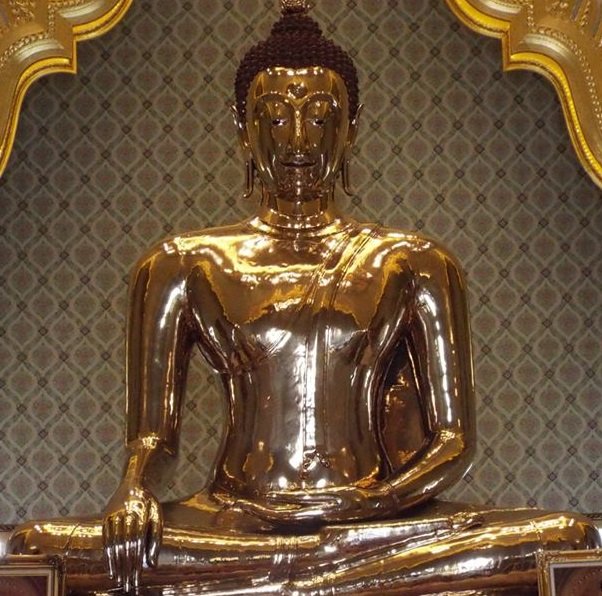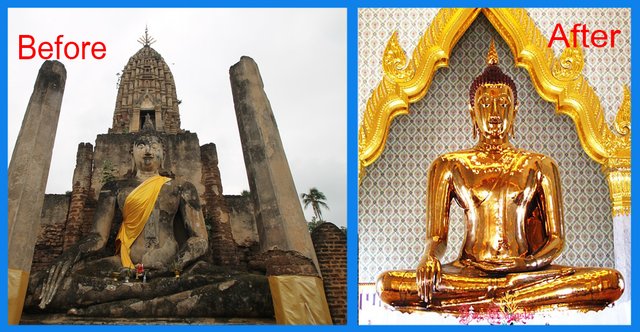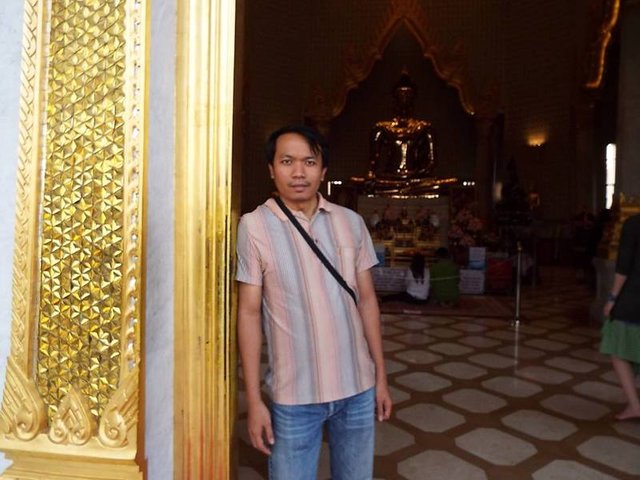5 tons of gold were hidden with plaster for several hundred years.

The origins of this statue are uncertain. It is made in the Sukhothai Dynasty style of the 13th-14th centuries, though it could have been made after that time. The head of the statue is egg-shaped, which indicates its origin in the Sukothai period. Given that Sukothai art had Indian influences and metal figures of the Buddha made in India used to be taken to various countries for installation, this suggests the Golden Buddha statue may have been cast in parts in India. Later, the statue was probably moved from Sukhothai to Ayutthaya, about 1403. Some scholars believe the statue is mentioned in the somewhat controversial Ram Khamhaeng stele. In lines 23-27 of the first stone slab of the stele, "a gold Buddha image" is mentioned as being located "in the middle of Sukhothai City," interpreted as being a reference to the Wat Traimit Golden Buddha. At some point, the statue was completely plastered over to prevent it from being stolen. The statue was covered with a thick layer of stucco, which was painted and inlaid with bits of coloured glass. It is believed that this plastering over took place before the destruction of Ayutthaya kingdom by Burmese invaders in 1767. The statue remained among the ruins of Ayutthaya without attracting much attention. In 1801, Thai King Buddha Yodfa Chulaloke (Rama I), after establishing Bangkok as a new capital city of the Kingdom, and after commissioning the construction of many temples in Bangkok, ordered that various old Buddha images should be brought to Bangkok from the ruined temples around the country. At the time of King Rama III (1824-1851), the statue, still covered with stucco, was installed as the principal Buddha image in the main temple building of Wat Chotanaram in Bangkok. When Wat Chotanaram, located near Chinatown, fell into disrepair and was closed, the statue was moved to its present location at the nearby Wat Traimit in 1935. At the time, Wat Traimit was a pagoda of minor significance (like hundreds of other Buddhist temples that exist in Bangkok). Since the temple didn't have a building big enough to house the statue, it was kept for 20 years under a simple tin roof. The true identity of this statue had been forgotten for almost 200 years.

Discovery of the golden statue
In 1954, a new Viharn building was built at the temple to house the statue. It was being moved to its new location on 25 May 1955 and there are a variety of accounts of what exactly happened next, but it is clear that during the final attempt to lift the statue from its pedestal, the ropes broke, and the statue fell hard on the ground. At that moment, some of the plaster coating chipped off, allowing the gold surface underneath to be seen. Work was immediately stopped so that an evaluation could be made. All the plaster was carefully removed and during the process, photos were taken, and are now displayed in the Temple for visitors. Pieces of the actual plaster are also on public display. When all the plaster was removed, it was found that the gold statue actually consisted of nine parts that fit smoothly together. A key was also found encased in plaster at its base, which can be used to disassemble the statue, allowing for easier transportation. The golden statue was discovered very close to the commemoration of the twenty-fifth Buddhist Era (2500 years since Gautama Buddha's passing) so the Thai news media was full of reports and many Buddhists regarded the occurrence as miraculous. On 14 February 2010, a large new building was inaugurated at the Wat Traimit Temple to house the Gold Buddha. The building also contains the Bangkok Chinatown Heritage Centre, and an exhibition on the origin of the Gold Buddha.

Characteristics
The statue is 3 metres (9.8 ft) tall and weighs 5.5 tonnes (5.4 long tons; 6.1 short tons). (According to another account, the statue measures 3.91 meters from base to top, and 3.10 meters across the lap from knee to knee.) It can be disassembled into nine pieces. The statue was housed in a wat in Ayutthaya until the mid 19th century, and its provenance from Ayutthaya excludes the possibility of it having been made after about 1750. At US$1,400 per troy ounce, the gold in the statue (18 karat) is estimated to be worth 250 million dollars. The body of the statue is 40% pure, the volume from the chin to the forehead is 80% pure, and the hair and the topknot, weighing 45 kg, are 99% pure gold.
Congratulations @worathi! You have received a personal award!
Click on the badge to view your own Board of Honor on SteemitBoard.
For more information about this award, click here
ถ้าคุณเป็นคนไทย ช่วยเขียนคำว่า #thai ลงในแท็กของคุณจะได้ไม๊โพสต์ของคุณจะได้มารวมกับเราชุมขนชาวไทยใน Steemit จากเรา หนึ่งใน #thaiteam
Congratulations @worathi! You received a personal award!
You can view your badges on your Steem Board and compare to others on the Steem Ranking
Vote for @Steemitboard as a witness to get one more award and increased upvotes!